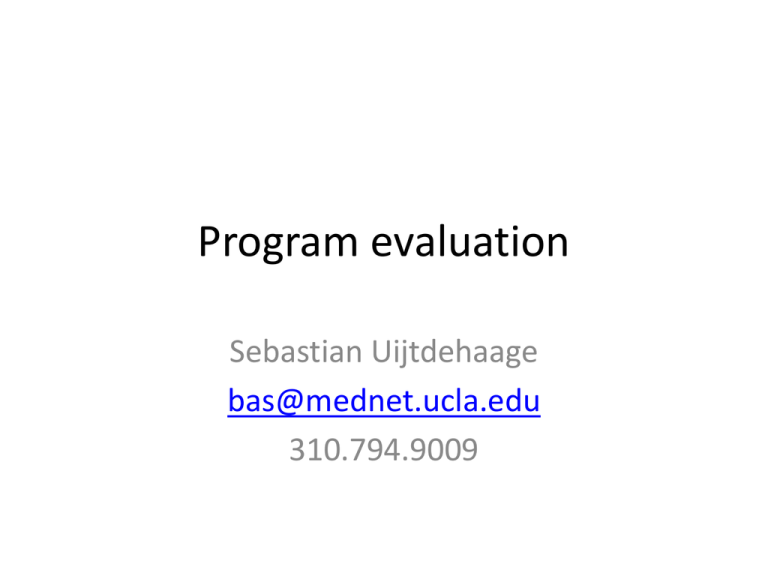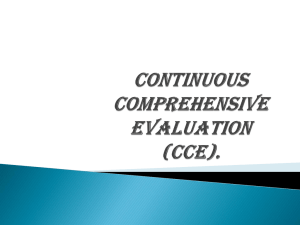CIPP Model of Program Evaluation
advertisement

Program evaluation Sebastian Uijtdehaage bas@mednet.ucla.edu 310.794.9009 Why do you evaluate? Five reasons of evaluating 1. FORMATIVE informs program development 2. SUMMATIVE demonstrate program’s success and impact 3. UNDERSTANDING how and why did program work? 4. DISSEMINATION sharing best practices 5. RECOGNITION scholarship, academic credit, leadership Stufflebeam 2003 What type of evaluation should I conduct? Outcome & Impact Did it work? Dan Stufflebeam: CIPP Model of Program Evaluation CONTEXT Needs Assessment PRODUCT What should we do? INPUT Program Planning Outcome & Impact How shall we do it? Does it work? PROCESS Implementation Are we doing as planned? What type of evaluation should I conduct? Formative or Summative? formative & summative evaluation Formative Evaluation Context Input What needs to be done? How should it be done? Process Is it being done? Product Is it working? Stufflebeam 2003 formative & summative evaluation Formative Evaluation Summative Evaluation What needs to be done? How should it be done? Were important needs addressed? Was program plan defensible? Process Is it being done? Product Is it working? Was the plan well executed? Did the effort make a difference? Context Input Stufflebeam 2003 What type of evaluation should I conduct? Quantitative or Qualitative? Quantitative or qualitative measures? Quantitative measures HOW MUCH…? Qualitative measures WHY and HOW? • How much did the participant change? • How much did the community change? • Why did the program work? • How did participants change as result? What makes good evaluation? Evaluation must be planned ahead • Evaluation should be part of program planning • Planning and resource allocation makes evaluation more successful – Example: long-term tracking of participants Confidence being admitted in a medical school 4.8 4.6 4.4 Start of program 4.2 End of program 4 3.8 3.6 Category 1 What else makes good evaluation? • Scientific rigor • Evaluation produces useful information that helps make decisions – Assessment should be done with a particular purpose in mind • Evaluation is tailored to your program objectives • Evaluation is done with conceptual framework in mind LOGIC MODEL CONDITIONS and DRIVERS Resources Activities The Planned Work Output Outcomes The Intended Results Impact LOGIC MODEL CONDITIONS and DRIVERS Current situation that precipitates the need for the program LOGIC MODEL CONDITIONS and DRIVERS Resources Resources operate the program: Activities and inputs Outputneeded toOutcomes Impact personnel, facilities, materials, equipment LOGIC MODEL CONDITIONS and DRIVERS Resources Activities Everything does if it had Impact access to Output the program Outcomes the resources LOGIC MODEL CONDITIONS and DRIVERS Resources Activities Output The “deliverables”—the events, products and services Outcomes Impact Number of participants, classes, brochures, advisors, etc LOGIC MODEL CONDITIONS and DRIVERS Resources Activities Output Outcomes If the program delivers, the participants will benefit Impact in certain ways: Knowledge, skills, behavior, attitudes Immediate, mid-term and long-term outcomes LOGIC MODEL CONDITIONS and DRIVERS Resources Activities Output Outcomes Impact If these benefits to participants are achieved, then certain changes in organizations and communities might be expected to occur LOGIC MODEL CONDITIONS and DRIVERS Resources Activities The Planned Work Output Outcomes The Intended Results Impact LOGIC MODEL • Links processes and outcomes: – Funders love this! • Great for program planning – Work backwards • Evaluation is built in! • Ain’t perfect Your turn…






